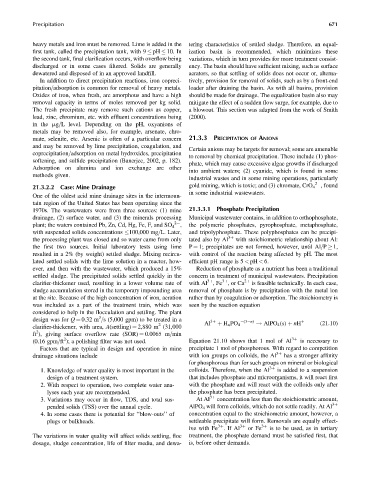Page 716 - Fundamentals of Water Treatment Unit Processes : Physical, Chemical, and Biological
P. 716
Precipitation 671
heavy metals and iron must be removed. Lime is added in the tering characteristics of settled sludge. Therefore, an equal-
first tank, called the precipitation tank, with 9 pH 10. In ization basin is recommended, which minimizes these
the second tank, final clarification occurs, with overflow being variations, which in turn provides for more treatment consist-
discharged or in some cases filtered. Solids are generally ency. The basin should have sufficient mixing, such as surface
dewatered and disposed of in an approved landfill. aerators, so that settling of solids does not occur or, alterna-
In addition to direct precipitation reactions, iron copreci- tively, provision for removal of solids, such as by a front-end
pitation=adsorption is common for removal of heavy metals. loader after draining the basin. As with all basins, provision
Oxides of iron, when fresh, are amorphous and have a high should be made for drainage. The equalization basin also may
removal capacity in terms of moles removed per kg solid. mitigate the effect of a sudden flow surge, for example, due to
The fresh precipitate may remove such cations as copper, a blowout. This section was adapted from the work of Smith
lead, zinc, chromium, etc. with effluent concentrations being (2000).
in the mg=L level. Depending on the pH, oxyanions of
metals may be removed also, for example, arsenate, chro-
mate, selenite, etc. Arsenic is often of a particular concern 21.3.3 PRECIPITATION OF ANIONS
and may be removed by lime precipitation, coagulation, and
Certain anions may be targets for removal; some are amenable
coprecipitation=adsorption on metal hydroxides, precipitation
to removal by chemical precipitation. These include (1) phos-
softening, and sulfide precipitation (Banerjee, 2002, p. 182).
phate, which may cause excessive algae growths if discharged
Adsorption on alumina and ion exchange are other
into ambient waters; (2) cyanide, which is found in some
methods given.
industrial wastes and in some mining operations, particularly
2
21.3.2.2 Case: Mine Drainage gold mining, which is toxic; and (3) chromate, CrO 4 , found
in some industrial wastewaters.
One of the oldest acid mine drainage sites in the intermoun-
tain region of the United States has been operating since the
1970s. The wastewaters were from three sources: (1) mine 21.3.3.1 Phosphate Precipitation
drainage, (2) surface water, and (3) the minerals processing Municipal wastewater contains, in addition to orthophosphate,
plant; the waters contained Pb, Zn, Cd, Hg, Fe, F, and SO 4 , the polymeric phosphates, pyrophosphate, metaphosphate,
2
with suspended solids concentrations 100,000 mg=L. Later, and tripolyphosphate. These polyphosphates can be precipi-
the processing plant was closed and so water came from only tated also by Al 3þ with stoichiometric relationship about Al:
the first two sources. Initial laboratory tests using lime P ¼ 1; precipitates are not formed, however, until Al=P 1,
resulted in a 2% (by weight) settled sludge. Mixing recircu- with control of the reaction being affected by pH. The most
lated settled solids with the lime solution in a reactor, how- efficient pH range is 5 < pH < 6.
ever, and then with the wastewater, which produced a 15% Reduction of phosphate as a nutrient has been a traditional
settled sludge. The precipitated solids settled quickly in the concern in treatment of municipal wastewaters. Precipitation
clarifier-thickener used, resulting in a lower volume rate of with Al ,Fe ,or Ca 2þ is feasible technically. In each case,
3þ
3þ
sludge accumulation stored in the temporary impounding area removal of phosphate is by precipitation with the metal ion
at the site. Because of the high concentration of iron, aeration rather than by coagulation or adsorption. The stoichiometry is
was included as a part of the treatment train, which was seen by the reaction equation
considered to help in the flocculation and settling. The plant
3
design was for Q ¼ 0.32 m =s (5,000 gpm) to be treated in a Al 3þ (3 n) ! AlPO 4 (s) þ nH þ (21:10)
2
clarifier-thickener, with area, A(settling) ¼ 2,880 m (31,000 þ H n PO 4
2
ft ), giving surface overflow rate (SOR) ¼ 0.0065 m=min
2
(0.16 gpm=ft ); a polishing filter was not used. Equation 21.10 shows that 1 mol of Al 3þ is necessary to
Factors that are typical in design and operation in mine precipitate 1 mol of phosphorous. With regard to competition
drainage situations include with ion groups on colloids, the Al 3þ has a stronger affinity
for phosphorous than for such groups on mineral or biological
1. Knowledge of water quality is most important in the colloids. Therefore, when the Al 3þ is added to a suspension
design of a treatment system. that includes phosphate and microorganisms, it will react first
2. With respect to operation, two complete water ana- with the phosphate and will react with the colloids only after
lyses each year are recommended. the phosphate has been precipitated.
3. Variations may occur in flow, TDS, and total sus- At Al 3þ concentration less than the stoichiometric amount,
pended solids (TSS) over the annual cycle. AlPO 4 will form colloids, which do not settle readily. At Al 3þ
4. In some cases there is potential for ‘‘blow-outs’’ of concentration equal to the stoichiometric amount, however, a
plugs or bulkheads. settleable precipitate will form. Removals are equally effect-
ive with Fe .IfAl 3þ or Fe 3þ is to be used, as in tertiary
3þ
The variations in water quality will affect solids settling, floc treatment, the phosphate demand must be satisfied first, that
dosage, sludge concentration, life of filter media, and dewa- is, before other demands.

